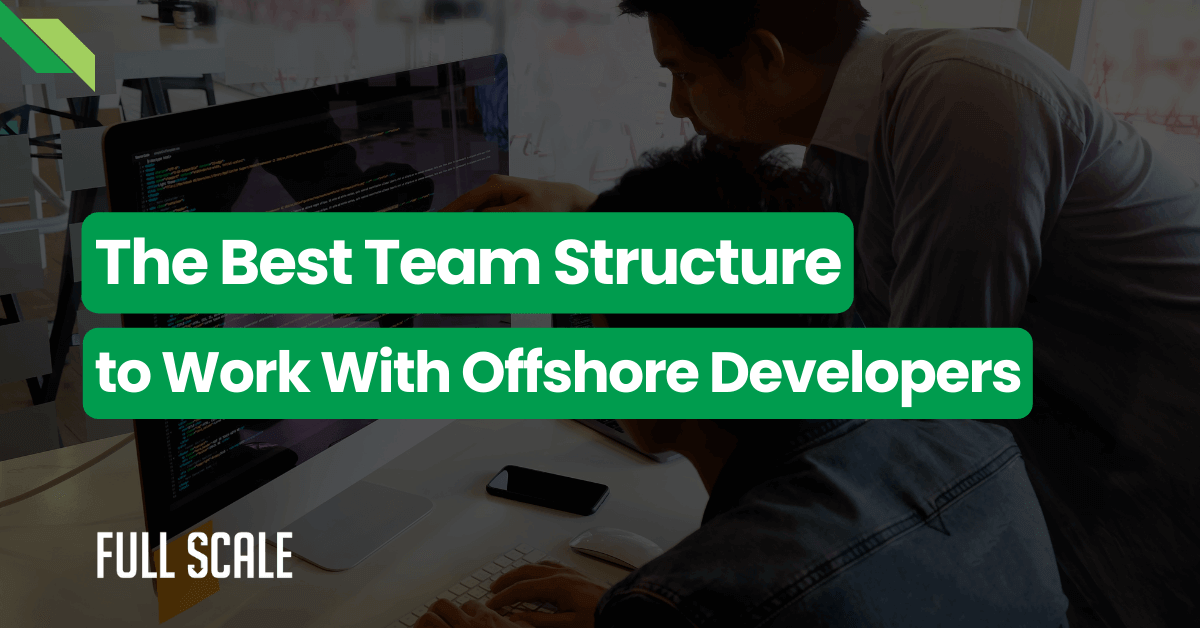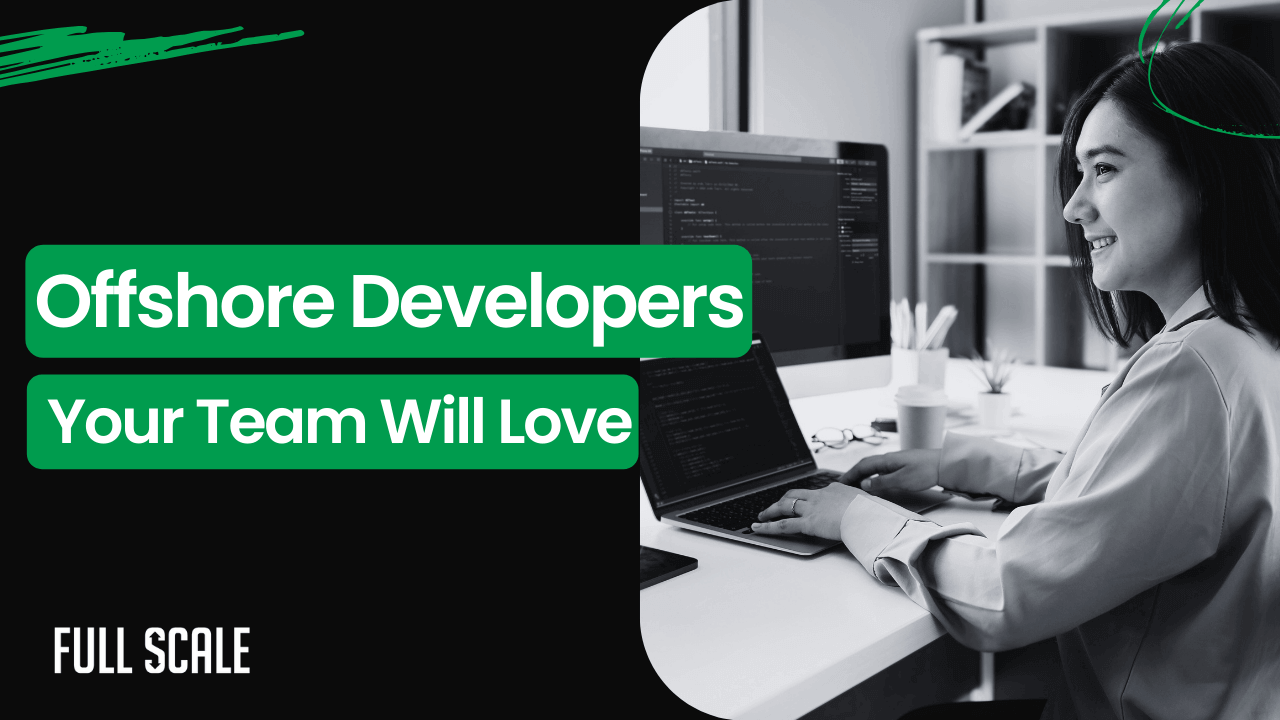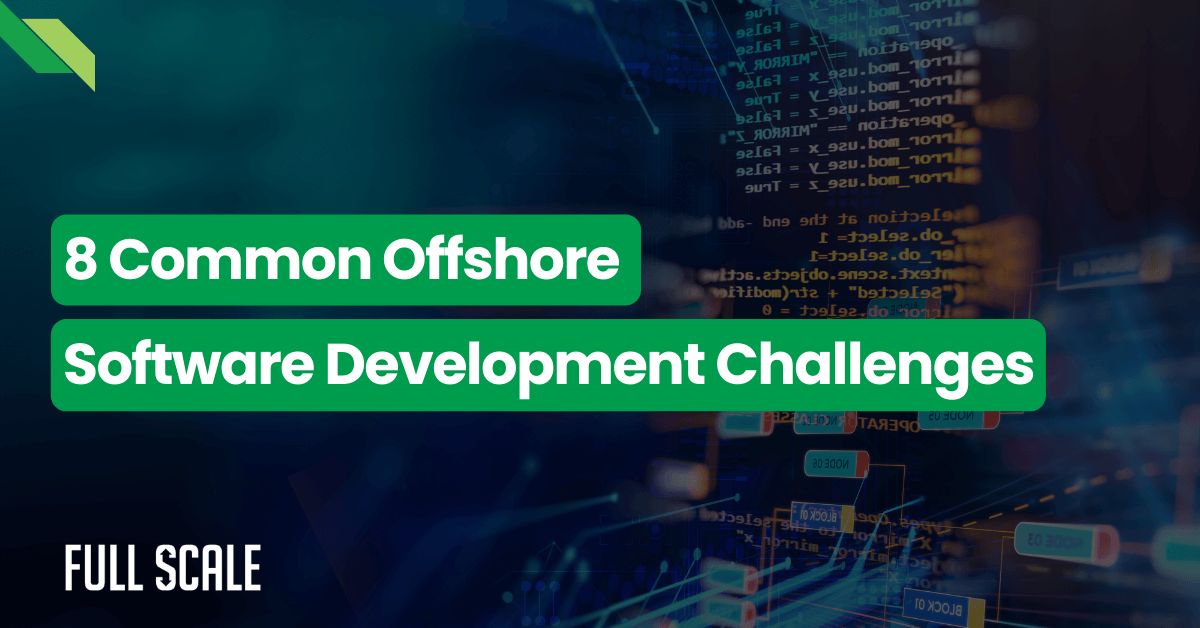Last Updated on 2025-10-01
After 15 years in tech, I was convinced offshore development problems were unsolvable. I’d burned through $2 million on failed projects and sworn off remote teams forever. Then I discovered why 90% of companies do it wrong—including me.
The truth hit me during a board meeting in 2021. I was explaining why we were eight months behind schedule and massively over budget. That’s when I realized the entire offshore development model is fundamentally broken.
What You'll Learn in This Article
The Brutal Reality of Offshore Development Problems
Most CTOs believe offshore development fails because of geography or culture. They’re dead wrong. The real problem is the outdated factory model that treats developers like disposable resources.
According to Deloitte’s 2024 Global Outsourcing Study, 59% of companies report dissatisfaction with offshore development outcomes. Meanwhile, Gartner found that 67% of offshore projects require significant rework.
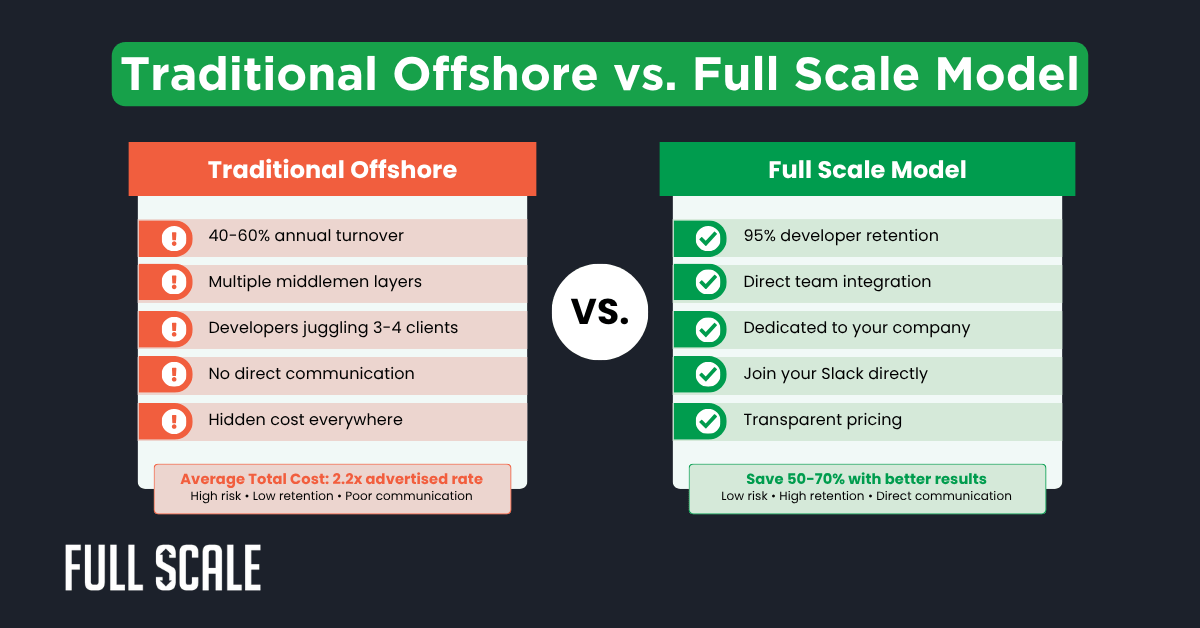
Why Offshore Development Fails: The Factory Model Problem
Here’s what nobody tells you about offshore development challenges. Traditional outsourcing companies run developer factories where your project is just another ticket. Your “dedicated” team is actually working on three other clients simultaneously.
The communication death spiral starts immediately:
- You explain the requirements to a project manager
- The PM translates it to a team lead
- The team lead assigns it to developers
- Each layer loses 20% of context
By the time the code is written, it barely resembles what you wanted. Then, the “yes culture” kicks in—developers agree to everything but deliver broken features.
The Hidden Cost Reality Most CTOs Miss
Let me show you the math that offshore companies don’t want you to see. This calculator reveals the true cost of traditional offshore development versus better offshore development models.
True Cost of Offshore Development Calculator
Discover the hidden costs that make offshore 2.2x more expensive than advertised
These hidden costs destroyed my budget three different times. Let me share exactly how each failure unfolded and what it taught me about fixing offshore development.
My $2 Million Education in Offshore Development Issues
Let me tell you about my expensive journey to fix offshore development. Each failure taught me exactly what doesn’t work and why.
Attempt 1: The Freelance Marketplace Disaster (2019)
I hired five “senior” developers from Upwork for our core platform rebuild. Within two weeks, two ghosted completely, and three produced code that looked like a junior’s first project. The freelancers had zero accountability—they just moved to the next gig.
Attempt 2: The Big Outsourcing Firm Trap (2020)
Next, I signed with a 500-person Indian outsourcing company. They promised dedicated teams but delivered their B-team while charging A-team prices. To them, we were just account number 847.
The project manager barely understood our product. The developers changed every few months due to high turnover. We spent more time explaining requirements than building features.
Attempt 3: The Boutique Agency Collapse (2021)
I thought a small Ukrainian shop would solve our offshore team management problems. Great sales pitch, talented developers, reasonable prices. Then geopolitical events scattered the team, and our project died overnight.
That’s when I realized the entire model was broken. We weren’t failing at offshore development—the traditional approach itself was the failure. But enough about my failures—let me show you what happens when you implement the right principles.
How to Make Offshore Development Successful: The Staff Augmentation Revolution
The solution to offshore development problems isn’t better project management or cheaper rates. It’s completely changing how you integrate remote developers into your team. Here’s the model that actually works.
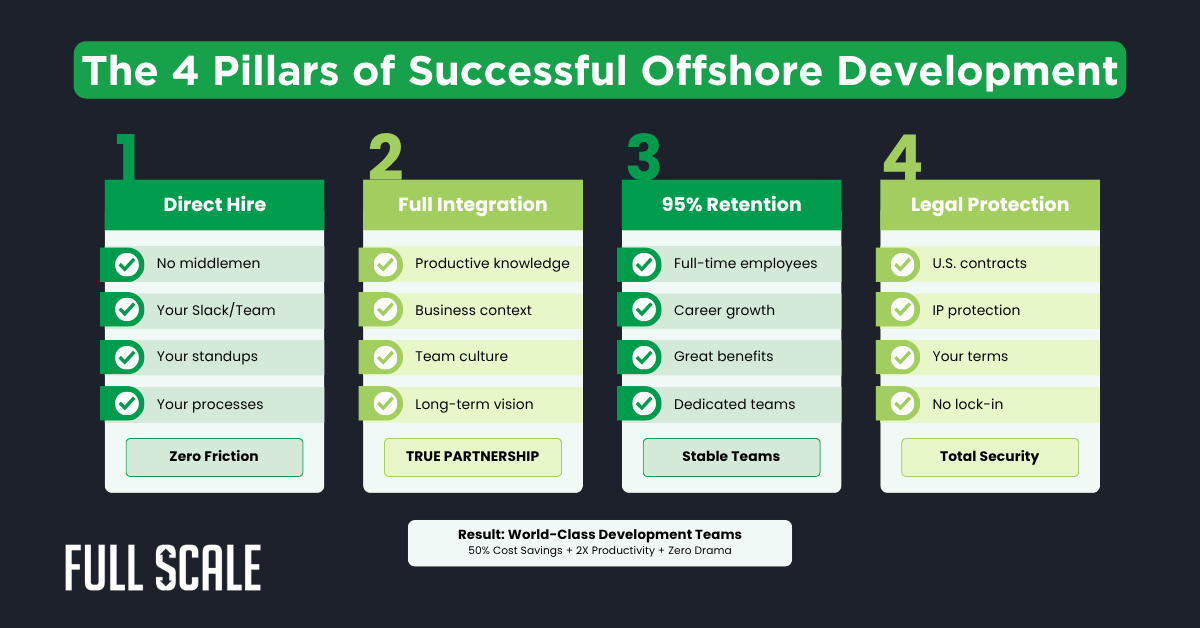
Our four-pillar approach eliminates every traditional offshore development challenge. Direct integration means no communication barriers, while 95% retention ensures knowledge stays with your team.
The Direct Integration Difference
Instead of working through project managers, our developers join your team directly. They’re in your Slack, attending your standups, using your tools. No translation layers, no broken telephone, no offshore team communication barriers.
This isn’t outsourcing—it’s building your team with talent that happens to be offshore. The geographical location becomes irrelevant when integration is seamless.
Why Developer Retention Changes Everything
Traditional offshore companies have 40-60% annual turnover because they treat developers poorly. We maintain 95% offshore developer retention because we treat them like actual employees, not disposable contractors.
Our developers get:
- Competitive salaries for their market
- Health benefits and career growth
- Dedicated to one client (you)
- Professional development opportunities
- Respect and genuine team membership
When developers stay, your investment in training pays off. Knowledge compounds instead of evaporating every few months. Now let me show you the real-world impact of this approach.
Real Results: How We Fixed Offshore Development Problems
Let me show you what happens when you fix offshore development the right way. These aren’t marketing promises—these are actual client results validated by McKinsey’s 2024 report showing direct integration models outperform traditional outsourcing by 3x in delivery speed.
Case Study: SaaS Startup Transformation
A fast-growing SaaS company came to us after three failed offshore attempts. They needed to scale quickly but couldn’t afford Bay Area salaries. Their previous offshore teams produced code that needed complete rewrites.
Before Full Scale:
- 6-month hiring cycles for each developer
- $180,000 average salary for U.S. developers
- Three failed offshore partnerships
- 8 months behind the product roadmap
After Full Scale:
- Scaled from 2 to 12 developers in 6 months
- 60% reduction in development costs
- 95% developer retention after 2 years
- Shipping features 2x faster than before
The CEO told me, “I can’t tell who’s in Kansas City and who’s in Cebu during standups. They’re just our team now.”
The Numbers That Prove Better Offshore Hiring Works
Here’s a comparison showing why our model delivers where traditional outsourcing fails:
Performance Comparison
See why direct integration beats traditional outsourcing every time
|
📊
Key Metrics
|
Traditional Offshore
Industry Average
|
Full Scale Model
Our Approach
|
|---|---|---|
|
Developer Retention
|
40-60%
⚠️
|
95%
✓
|
|
Time to First Hire
|
6-8 weeks
🐌
|
2 weeks
⚡
|
|
Communication Model
|
Through PMs
👥
|
Direct
💬
|
|
Code Rework Rate
|
35-45%
🔄
|
<5%
✨
|
|
True Cost Savings
|
10-20%
📉
|
50-70%
💰
|
|
Client NPS Score
Net Promoter Score
|
12
😔
Poor
|
72
🌟
Excellent
|
These metrics show why direct integration beats traditional outsourcing every time. When you eliminate middlemen and invest in retention, everything improves. But is this approach right for your specific situation?
Is This Model Right for Your Offshore Development Challenges?
Not every company is ready to fix offshore development problems the right way. Here’s how to know if our model fits your situation.
You’re Ready If:
- You need 3+ developers for long-term projects
- You have clear technical leadership in place
- You value retention and knowledge preservation
- You want team members, not task completers
- You’re tired of managing offshore development issues
You’re Not Ready If:
- You need a quick 2-week project completed
- You have no technical leadership structure
- You’re looking for the absolute cheapest option
- You can’t invest time in proper onboarding
- You see developers as interchangeable resources
The companies that succeed with our model understand a simple truth. Successful offshore development isn’t about finding cheaper labor—it’s about building better teams.
Why Partner with Full Scale
We’ve helped 200+ companies overcome offshore development problems. Here’s what makes us different:
- Direct Integration from Day One – Your developers join YOUR team, not ours
- 95% Developer Retention Rate – Because we treat developers as professionals, not commodities
- U.S.-Based Contracts – Full legal protection for your IP and code
- No Middleman Markup – You manage developers directly, saving 40% on costs
- 2-Week Hiring Process – Pre-vetted senior developers ready to start
- Monthly Flexibility – Scale up or down based on your needs
- Dedicated Account Support – U.S.-based team for any issues
- Cultural Alignment Training – Developers learn your product, not just tasks
According to Accelerance’s 2024 Global Software Outsourcing Report, only 23% of companies achieve successful offshore partnerships. The difference? They use direct integration models instead of traditional outsourcing.
Stop Fighting Broken Models
If you’re tired of offshore development problems, let’s talk. We’ll assess if our model fits your needs—no sales pitch if we’re not the right solution.
We don’t do outsourcing—we do staff augmentation. Your developers work directly for you, integrated into your team from day one. No project managers, no account managers, just direct collaboration with talented developers who become part of your team.
We hire developers as full-time employees with benefits, career growth, and respect. They work on one client (you) instead of juggling multiple projects. When developers feel valued and have stability, they stay.
Our developers in the Philippines overlap 4-6 hours with the U.S. time zones. They adjust schedules for important meetings and join your daily standups. Plus, they’re in your Slack responding in real-time during overlap hours.
Most clients hire their first developer within 2 weeks. We can scale teams from 1 to 20+ developers, typically adding 2-3 developers monthly. The limit is usually your onboarding capacity, not our talent pipeline.
You pay a flat monthly rate per developer with no hidden fees. This includes the developer’s salary, benefits, our overhead, and support. Most clients save 50-70% compared to U.S. hiring while getting senior-level talent.

Matt Watson is a serial tech entrepreneur who has started four companies and had a nine-figure exit. He was the founder and CTO of VinSolutions, the #1 CRM software used in today’s automotive industry. He has over twenty years of experience working as a tech CTO and building cutting-edge SaaS solutions.
As the CEO of Full Scale, he has helped over 100 tech companies build their software services and development teams. Full Scale specializes in helping tech companies grow by augmenting their in-house teams with software development talent from the Philippines.
Matt hosts Startup Hustle, a top podcast about entrepreneurship with over 6 million downloads. He has a wealth of knowledge about startups and business from his personal experience and from interviewing hundreds of other entrepreneurs.


